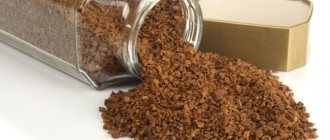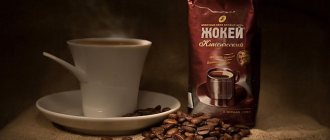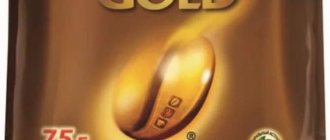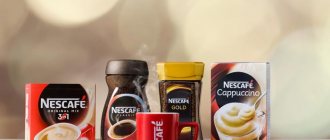A large number of people in our world love the drink coffee. Many people cannot live a day without drinking a cup or two of aromatic coffee. Some people know how to invigorate themselves with the help of a drink, some like the taste, and some are simply addicted. You can’t argue with everyone, because everyone has their own taste. But it’s worth remembering that coffee has its pros and cons, and in general, you shouldn’t overdo it with any drink or food, even healthy ones. Therefore, it is better to observe the measure.
How much do you know about this drink? Our useful website will tell you everything. Let's consider what kind of Nescafe brand coffee is, what types there are, what characteristics, reviews from fans.
History of Nescafe
In 1929, the head of the Swiss company Nestle, which was then only engaged in the production of baby food and condensed milk, received an interesting offer from his banker. The bank has stocks of coffee beans unsold due to the crisis in its Brazilian warehouses. Bags of expensive raw materials took up a lot of space, a new harvest was ripening, and the grains in the warehouse could be damaged by mold. So the bank suggested taking several bags for experiments, using its chemical engineers and coming up with a form for coffee that would allow the product to be stored for a long time and offered to the consumer in a form ready for dissolution. Similar to the Maggi cube, which was gaining popularity at that time.
The Nestle company invited the famous Swiss chemist Max Morgenthaler to work in its laboratory and entrusted him with leading the process of searching for new forms of coffee. Basic research and experiments lasted 3 years. There were results, but they did not satisfy the researchers: the coffee powder dissolved poorly, its taste was not good enough, and powdered milk and sugar, which improved the organoleptic characteristics of the drink, created problems in obtaining the final product.
Max Morgenthaler spent another year trying to prove the effect of high temperatures and pressure on the speed of coffee processing. And when I was convinced that the coffee began to dissolve properly after heating and pressure, I began experimenting with carbohydrates, which helped preserve the aroma.
In 1937, Morgenthaler presented the results of the work of his experimental group to the board of directors of Nestle, and in April 1938, Nescafe instant coffee appeared on the Swiss market. The product launched in Britain in the summer, and by early 1939 it entered the United States market. A year later, instant coffee was already sold in thirty countries around the world.
During the Second World War, the main consumers of Nescafe coffee were the Swiss, British and Americans. Buyers appreciated the capabilities of the new drink: long shelf life, ease of preparation, decent taste. And the American soldiers liked the coffee: to meet the demand of the warring army, in 1943 the US government ordered the construction of 2.
The war ended, and the development of the brand went on as usual:
- in 1952, the French company Nescafe offered an innovative product without carbohydrates;
- in the early 60s, coffee in glass jars began to be produced in Europe and Japan;
- in 1965, the brand presented the freeze-dried instant Gold Blend;
- in the 90s, a foaming mixture was developed and patented, which is still used today in instant Cappuccino;
- in 2006 they launched a new product - the Dolce Gusto coffee maker with coffee capsules;
- in 2008, they developed the Barista coffee machine and the Alegria, Milano and Viaggi coffee systems, which are now installed all over the world and provide lovers of the aromatic drink with 175 cups of coffee per second;
- in 2014, the appearance of the products was updated, the shape of the red mug was changed and a new slogan was invented: “It all starts with Nescafe!”
And all this time, the brand has been expanding the range of recipes, creating different versions of the drink. Over 80 years, 300 types of products have been released under the Nescafe brand, and the surprises pleasant for fans of the brand do not end there.
Interesting Facts
- Instant coffee was invented by the Japanese chemist Satori Kato in 1901, and two companies even began producing it. But the drink turned out to be so tasteless that there were few buyers and they stopped producing it. The Nestle company has improved the manufacturing process and achieved minimal losses in the quality of the original product - coffee beans. As CEO Ulf Mark Schneider said, “We may not have invented instant coffee, but we were the first to get it right.”
- During World War II, the brand was so popular among American soldiers that those built in the States sent all their products to the front to supply the army. So the first brand ambassador of the brand was the US Armed Forces.
- The name Nescafe is a symbiosis of two words: Nestle and Cafe.
- The first conquerors of Everest, Edmund Hillary and Norgay Tenzing, climbed to the top with backpacks containing Nescafe.
- Nescafe became the first lunar coffee brand - it was taken with the Apollo 11 astronauts when they landed on the Moon.
How did Nescafe come about?
Nescafe is the brainchild of the famous manufacturer of various food products, Nestle. This brand appeared in the late thirties of the last century and in a couple of decades won worldwide love. The reason for starting the production of instant coffee was the appeal of Brazilian entrepreneurs to the Nestle company. They asked for help in selling coffee beans.
At that time, there was already instant coffee on the market, but it was not popular due to its low taste. The company's specialists have been working for eight years to improve production technology and improve the taste of instant coffee products. Thanks to this, the first instant Nescafe appeared. It was immediately exported from Switzerland to France, Great Britain and the USA.
According to the manufacturer, then the composition of instant coffee included only coffee beans. This was achieved by inventing a technology that did not use a carbohydrate base. A little later, already in 1960, they began to flavor coffee and learned to produce granulated and freeze-dried products.
Nescafe range
The brand produces products from high-quality Arabica and Robusta coffee beans. The instant drink is more expensive than other brands because its production uses high energy intensity.
The drink is made in different degrees of roasting, so everyone will choose the option that suits them. The Nescafe company produces only natural, high-quality products that do not contain foreign impurities.
Nestlé produces the following varieties of coffee:
Nescafe Crema
The product was produced for connoisseurs of real coffee. The brewed drink has a delicate aroma, a classic rich taste, and an airy foam forms on top. For the production of Nescafe Classic Crema, selected varieties of high quality grains are used.
Nescafe Gold
Belongs to the class of elite drinks. Carefully selected beans give the brewed coffee a pleasant, delicate taste and vanilla aroma. Nescafe Gold instant coffee is packaged in 500 g cans, glass jars of 250, 100 and 50 grams, and you can also buy the product packaged in 150 and 75 grams.
Nescafe Gold Decaf
Thanks to special new technologies for manufacturing the product, coffee retains its taste, aroma and beneficial properties for a long time. Gold Decaf contains virtually no caffeine. It can be bought in glass jars weighing 50 and 95 grams.
Nescafe Classic
The most famous drink of this brand. It has a rich aroma and a slight bitterness in taste. It is made from Brazilian coffee blend, which is collected from the best coffee plantations. The classic is sold packaged in tins for long-term preservation of aroma and beneficial properties.
Nescafe Kulta
Coffee comes from Finland. Manufactured for sales in Finland and Sweden, where there is great competition between suppliers. The instant drink Nescafe Cult is one of the most famous in many countries. The brewed drink has a captivating aroma and unsurpassed taste that will give you a boost of energy throughout the day.
Nescafe Espresso
It is produced from the best varieties, with a dark degree of roasting. Thanks to the aromatic light foam and noble taste, Espresso is reminiscent of Italian coffee. The drink goes perfectly with cream and milk.
Nescafe Mocambo
It has a traditional taste and unforgettable aroma, thanks to the perfect combination of Arabica and Robusta. Its price is affordable not only for elite restaurants, but also for small coffee shops. The product is packaged in half kilogram packs.
Nescafe Green Blend
This is not just a tasty and aromatic drink, it is a means to preserve beauty and youth. This effect is created because the product contains green, unroasted and roasted grains. Green Blend is rich in antioxidants, containing as much as green tea. Brewed Nescafe has a light original taste and fresh aroma. It is sold in a 100 gram glass jar or in soft bags of 70 and 150 grams.
Nescafe Alta Rica
The drink contains dark-roasted Latin American varieties, which give brewed Alta Rica a strong almond flavor and a wonderful spicy aroma. It is good for preparing drinks such as cappuccino, mochaccino or espresso. Produced in glass jars of 95 grams and in half-kilogram bags.
Nescafe Excella
Made from elite varieties of Japanese beans, its properties will be appreciated by true coffee lovers. A freshly brewed drink has an exquisite aroma and original taste, which is preserved in cold coffee. It can be bought in glass jars of 200 grams.
Nescafe's assortment also includes the following types: Montego, Espiro, President, Estet, Brazero, Kenjara and others.
Nescafe three in one, which also includes milk and sugar, is produced in packs of twenty sachets. Nescafe three in one Extra Strong contains seventy percent caffeine and is available in sticks. Dolce Gusto is produced in capsules for brewing the drink in a coffee maker.
Advantages and disadvantages of instant coffee
To understand the pros and cons of the drink, you need to know the features of its production. First of all, to make instant coffee, ground beans are treated with hot water for a long time to obtain a concentrated solution. Further processing proceeds depending on the type:
- Freeze-dried (also called freeze-dry) - produced by the “drying-sublimation” method. The coffee concentrate is frozen and the crystals are vacuum dehydrated. This method allows you to preserve the greatest amount of useful substances, but due to complex technology, freeze-dried varieties are more expensive.
- Powder - the production process consists of drying droplets sprayed into a chamber by streams of hot air.
- Granular - made from powder. The aggregation method is used, when during drying the particles are wetted with water and granules are formed from them.
As it becomes clear from the description of the process, no matter what method is chosen, it is impossible to preserve all useful substances. A significant part of the volatile components and flavonoids evaporates, but the concentration of caffeine and organic acids in the soluble product is higher than in the beans.
As a result, the drink has a weaker aroma compared to the natural one. In order to correct this, manufacturers use additives: in expensive varieties - natural coffee oils, and in the budget segment - synthetic flavors.
The advantages of an instant drink include ease of preparation. In addition, this coffee can be drunk by people suffering from low stomach acidity: it helps improve secretion and stimulation of the gallbladder.
Compared to natural coffee, instant coffee contains fewer calories. In addition, it helps remove excess fluid. Therefore, it can be drunk by those who are on a weight loss diet.
The increased caffeine content can be considered both a plus and a minus. On the one hand, a cup of such a drink will make you wake up faster and restore vigor. On the other hand, people with cardiovascular diseases need to be careful. Excessive consumption of instant coffee can lead to serious problems.
But the main harm of instant coffee is not the high caffeine content, but the presence of synthetic additives, flavorings and preservatives. With their help, manufacturers try to improve the taste and aroma.
Attention!
It should be remembered that, together with water, instant coffee removes calcium from the body. Therefore, it is not recommended to drink the drink during pregnancy and breastfeeding.
Reviews of Nescafe coffee
Customer reviews vary, because everyone has their own individual taste, but almost everyone does not remain indifferent to the already classic tastes of Nescafe coffee. Therefore, most people prefer this brand. Some people buy coffee because of the relatively low price, while others note that the manufacturer keeps the quality of taste high.
Some consumers do not find the coffee strong enough; some prefer to add milk and cream. But everyone agrees that the drink has a pleasant aroma. Most of the criticism is directed towards Nescafe 3 in 1, since it has practically nothing in common with real coffee, the taste and quality leave much to be desired.
Nescafe is the favorite drink of millions of people around the world.
Composition and calorie content of coffee
Instant coffee can be considered a diet drink. 100 g of finished drink contains on average:
- fat - 0 g;
- proteins - 0.1 g;
- carbohydrates - about 0.3–0.4 g;
- water - 99.1 g;
- ash - 0.2 g.
Instant coffee also contains vitamin B3 (0.02 g), potassium (30 mg), a small amount of selenium, magnesium and phosphorus. The calorie content of the drink per 100 g is 2 kcal.
Counterfeits and how to spot them
Nescafe coffee is rarely counterfeited in large quantities. However, there are large quantities of counterfeit goods. So, from 2005 to 2006, a gang from St. Petersburg produced counterfeit goods and distributed them throughout major Russian cities. Production volumes were comparable to industrial production.
To distinguish the original from a fake, just look carefully at the packaging. It is necessary to pay attention to the price of coffee - a low price is a reason for caution.
Low-priced coffee may contain chicory or malt. The packaging will not be of the same quality and may lose its seal.
The markings on counterfeit cans are already on the cans, not glued on. It is extremely important to find the date, country of origin, and barcode. The first 3 digits of the barcode must match the country of origin code. And, of course, the taste, aroma and type of coffee granules will differ.











